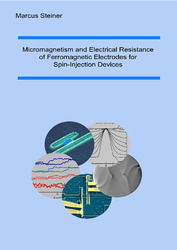| Fachbereiche | |
|---|---|
| Buchreihen (96) |
1378
|
| Nachhaltigkeit |
3
|
| Gesundheitswesen |
1
|
| Geisteswissenschaften |
2364
|
| Naturwissenschaften |
5406
|
| Mathematik | 229 |
| Informatik | 319 |
| Physik | 980 |
| Chemie | 1363 |
| Geowissenschaften | 131 |
| Humanmedizin | 243 |
| Zahn-, Mund- und Kieferheilkunde | 10 |
| Veterinärmedizin | 108 |
| Pharmazie | 147 |
| Biologie | 835 |
| Biochemie, Molekularbiologie, Gentechnologie | 121 |
| Biophysik | 25 |
| Ernährungs- und Haushaltswissenschaften | 45 |
| Land- und Agrarwissenschaften | 1004 |
| Forstwissenschaften | 201 |
| Gartenbauwissenschaft | 20 |
| Umweltforschung, Ökologie und Landespflege | 148 |
| Ingenieurwissenschaften |
1793
|
| Allgemein |
98
|
|
Leitlinien Unfallchirurgie
5. Auflage bestellen |
|
Erweiterte Suche
Micromagnetism and Electrical Resistance of Ferromagnetic Electrodes for Spin-Injection Devices
Marcus Steiner (Autor)Vorschau
Inhaltsverzeichnis, Datei (440 KB)
Leseprobe, Datei (530 KB)
In the present work the characteristics of microstructured hybrid ferromagnet/semiconductor devices are presented. A Hall micromagnetometry study of permalloy rings reveals the “onion”, the “vortex”, and the “local vortex” state for different magnetic fields. These magnetic states are stable up to room temperature as proven by magnetic-force microscopy. The variation of the geometrical parameters of the rings offers the possibility to control the switching fields and the overall magnetic behavior. Micromagnetic simulations are used to investigate the rings numerically and are in very good accordance with the measurements. Two different types of rectangular permalloy elements are investigated by transport measurements, namely single-domain and multi-domain samples. The anisotropic magnetoresistance is the governing resistance contribution. In the single-domain sample the classical anisotropic magnetoresistance is measured as well as additional resistance jumps. The angle dependence of the switching fields indicates the switching mode, which is identified as a curling-like magnetization reversal. In multi-domain samples the transport data become more difficult to interpret but it is shown by micromagnetic simulations that the main contribution to the resistance is generated by the anisotropic magnetoresistance. Domain-wall contributions to the resistance can be neglected in the present samples. To inject spin-polarized electrons from a ferromagnet into a semiconductor, two approaches are followed. In the first, both materials are contacted directly. Small magnetoresistance changes are detected which are in accordance with model calculations. In a second approach, the spininjection efficiency is enhanced by a tunnel barrier which is integrated between ferromagnet and semiconductor. The temperature dependence of the observed magnetoresistance jumps in both experiments resemble each other. This provides a hint for the successful injection of spin-polarized electrons into the semiconductor.
| ISBN-13 (Printausgabe) | 3865371760 |
| ISBN-13 (Printausgabe) | 9783865371768 |
| ISBN-13 (E-Book) | 9783736911765 |
| Sprache | Deutsch |
| Seitenanzahl | 74 |
| Auflage | 1 Aufl. |
| Band | 0 |
| Erscheinungsort | Göttingen |
| Promotionsort | Hamburg |
| Erscheinungsdatum | 20.09.2004 |
| Allgemeine Einordnung | Dissertation |
| Fachbereiche |
Physik
|








